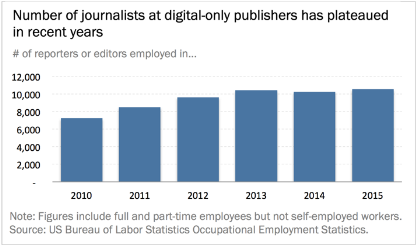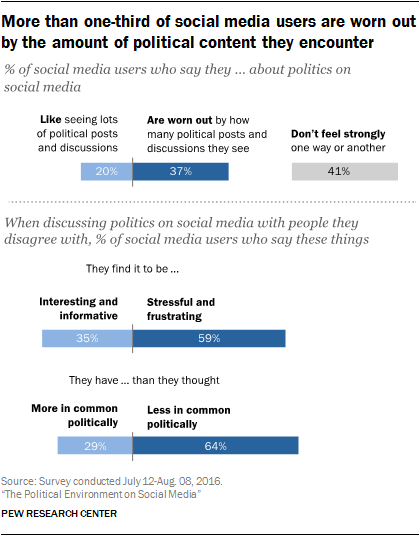Politics on social media, news in text vs. video, digital journalism jobs, millennial vs. baby boomer marketers, and more are covered in this installment of TFP’s Media Metrics roundup.
To help you keep up with trends and prepare for changes just around the corner, each month we compile excerpts from some key reports covering issues affecting the publishing and media industries. Here are our top picks.
The Political Environment on Social Media (Pew Research Center)
- A Pew Research study found that 37% of social media users are “worn out” by the volume of political content they see in their feeds, almost twice the number of those who want to see a lot of political information (20%). However, 41% indicated that they don’t feel strongly about the amount of political coverage in their social feeds.
- The report said 59% of social media users view interactions with those who have opposing political views as “stressful and frustrating,” while 35% said such interactions are “interesting and informative.”
- Half of users believe political discourse on social media is angrier (49%), less respectful (53%), and less civil (49%) than that encountered elsewhere.
- Most social media users (83%) said they ignore opposing political views posted by friends and family, while only 15% respond to such posts.
Pew: Younger Adults Prefer to Get Their News in Text, Not Video (Nieman Lab)
- According to another Pew Research study, 46% of U.S. consumers polled said they would rather watch the news than read it.
- However, that number is considerably lower for those 18 to 29 years old, with only 38% of the demographic citing video as their preferred news format.
- A higher percentage of that age group (42%) would rather read text online, while only 19% of young adults prefer listening to news.
Employment Picture Darkens for Journalists at  Digital Outlets (Columbia Journalism Review)
Digital Outlets (Columbia Journalism Review)
- A report citing Bureau of Labor Occupational Employment Statistics (OES) data highlighted a large drop in newspaper jobs in the past decade: While newspaper editorial staff numbered 66,490 in 2005, that number dropped to 41,400 by 2015—a 38% decline.
- In the same period, digital-only publishers more than tripled staff, expanding from 3,410 journalists to 10,580. However, the data also shows the number of digital-only journalists hired since 2013 has plateaued, with the total number ranging from 10,240 to 10,580 in the past three years.
- Overall, the number of journalists employed across both print news publications and digital-only media dropped 26% over the 10-year period: 69,900 in 2005 vs. 51,980 in 2015.
Report: Millennials Driving Change in Marketing, Media (Social Times)
- A recent survey of small and midsize businesses found millennial marketers spend 58% of their budget on digital media compared with just 14% of their baby boomer counterparts.
- 41% of millennial marketers said most of their budget is spent on mobile, while only 10% of boomers said the same.
- Of all SMBs surveyed, 44% said they depend on social ads for brand awareness. But there’s a big split between millennials and boomers on that: 68% vs. 27%, respectively. Similarly, while 41% overall said they rely on social ads for revenue, there’s a divide between millennials (60%) and baby boomers (27%).
Digital Ads to Overtake Traditional Ads in U.S. Local Markets by 2018 (Advertising Age)
- According to a BIA/Kelsey 2017 forecast, digital advertising in local markets, including mobile, will increase 13.5%, from $44.2 billion to $50.2 billion year over year.
- In contrast, local advertising via traditional media is projected to decline by 2.4% over the same period, from $101.1 billion to $98.6 billion.
- Local ad revenue across all media will see just a slight increase (2.4%) in 2017, to $148.8 billion.
Native Ads Will Provide 25 Percent of Ad Revenues by 2018, Says Media Association (Poynter)
- By 2018, native advertising as a percentage of news media ad revenues will increase to 25% compared with 11% today, according to a study by the International News Media Association and the Native Advertising Institute.
- It found 48% of news organizations are currently offering some form of native ads, while 39% are planning to offer them.
- Of those that offer native advertising, 42% produce the content with their own editorial teams, while 26% use an external agency partner.
- However, the report said 38% have concerns about “lack of separation of the editorial and commercial sides of the business” and see that as “a threat to proper execution of native advertising.”
Google and Facebook Are Booming. Is the Rest of the Digital Ad Business Sinking? (Recode)
- According to data compiled by trade group Digital Content Next, Google and Facebook accounted for virtually all the growth in U.S. digital advertising in the first half of 2016, meaning the rest of the industry collectively shrank, Recode reported.
- It said Google’s ad revenue grew 22%, accounting for 60% of year-over-year digital ad growth, while Facebook’s ad revenue jumped 67%, accounting for 43% of that growth (for total growth of 103%).
Facebook Scores Big in Q3 Earnings: $7.01B Revenue and 1.79B Users (TechCrunch)
- Facebook beat expectations in the third quarter, with $7.01 billion in revenue and $1.09 in earnings per share.
- The social platform reported 16% year-over-year growth in monthly users, hitting 1.79 billion. Daily active users increased to 1.18 billion from 1.13 billion last quarter, reflecting 17% growth compared with the same period last year.
- It also reached 1.66 billion mobile monthly active users in Q3, up 5.7% from the previous quarter, and a new milestone: 1.055 billion mobile-only users.
Study: 79 Percent of Online Americans Use Facebook (Social Times)
- According to Pew research, 79% of Americans use Facebook, more than double the number who use Instagram (32%), Pinterest (31%), LinkedIn (29%), and Twitter (24%).
- In terms of demographics, 62% of online users aged 65 and up now use Facebook, up from 48% in 2015. The study also found 83% of users are female while 75% are male.
- Females are also more likely to use Instagram (38% vs. 26% of men) and Pinterest (45% vs. 17%).
- Meanwhile, of all online adults with college degrees, half use LinkedIn and 29% use Twitter.
Younger Internet Users More Likely to Block Ads Worldwide (eMarketer)
- Research by Kantar TNS shows that nearly one in five Internet users (18%) worldwide block ads.
- Its most recent survey found younger adults are more likely to use ad blocking technology than older users: 20% of respondents 16 to 34 years old said they use ad blockers, while use among those aged 55 to 65 actually dropped to 14%.
- Providing further insight, a GlobalWebIndex study found 55% of users said they block ads because too many of them are “annoying or irrelevant.” Other complaints included ads “take up too much space and get in the way” (48%) and ads are “intrusive” (44%).
Media Metrics is a monthly feature from Technology for Publishing, aimed at keeping you armed with the latest industry data. If you’d like to share something you’ve read, drop us a note. And keep up with the latest industry news coverage by signing up for our This Week in Publishing emails and our Publishing Innovations newsletter.
Posted by: Margot Knorr Mancini



